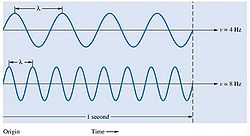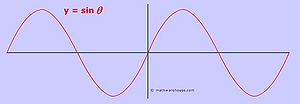Wavelength
Claimed by Daniel Yu, Fall 2023
Wavelength
To begin, wavelength, a fundamental aspect of physics and mathematics, is the distance during which a wave's shape repeats. Wavelength is usually determined by measuring the distance between repeating patterns. Wavelength is commonly designated by the Greek letter, lambda (λ), and the SI unit of wavelength is nanometers(nm). Different length in wave cause different colors to be reflected. The concept can also be applied to periodic waves of non-sinusoidal shape. Sinusoidal shapes are the shapes of cosine and sine graphs. The term wavelength is also sometimes applied to modulated waves, which are the waves transmitted when information is conveyed. If a sinusoidal wave moving at a constant speed, wavelength is inversely proportional to frequency of the wave: waves with higher frequencies have shorter wavelengths, and lower frequencies have longer wavelengths. The formula for frequency and wavelength is v=fλ. Wavelength depends on the medium that a wave travels through, such as air, vacuum, and water. Wavelength is a measure of the distance between repetitions of a shape feature such as peaks, valleys, or zero-crossings, not a measure of how far any given particle moves.
A Deeper Dive into Sinusoidal Waves and Fundamental Wavelength Understanding
Sinusoidal waves, also known as sine waves, have a very simple and regular pattern. Thus, they are easy to model as well as analyze. As illustrated in the mathematical models, sinusoidal waves have a simple mathematical representation as illustrated by the equation y = sin(θ). Furthermore, many natural phenomena such as light, sound, and electromagnetic waves exhibit sinusoidal behavior. Through understanding sinusoidal waves and its applications and existence in the real world, one can gain a better understanding of natural processes. The relationship of a sinusoidal wave can be described as wavelength = speed / frequency.
𝜆 = 𝑣 𝑓
Example
For example, think of a equation such as y = sin(θ) involving a line that fluctuates within [-1,1]. The distance measured from the peak at 1 to the next peak at 1 is the wavelength of that specific equation. Conversely, the distance measured from the trough at -1 to the adjacent trough at -1 would be equal to the distance measured from the peaks. This example seeks to highlight the fundamental, repeating nature of wavelength.
(An equation to illustrate the relationship between wavelength and frequency, as depicted above)
(A figure to demonstrate how varying frequencies result in differing wavelength shapes given their inverse relationship)
Wave Propagation
The refraction index (n) of a medium is a measure of how much that medium influences the speed of light in comparison to a vacuum. This equation is illustrated by v = c / n. 'v' is the speed of light in that medium, 'c' is the speed of light in a vacuum, and 'n' serves as the refractive index of that medium. The implications of this idea illustrate how wavelength can become shorter within a medium. For example, given the fact that the speed of light is reduced in mediums such as glass or water, the wavelength becomes shorter for a given frequency. Furthermore, when light waves encounter a change in the refractive index, they can bend, thus "changing" direction. This is the idea behind refraction, which is the bending of a wave as it passes from one medium to another.
A Mathematical Model
We can easily determine wavelength for sinusoidal shaped graphs. For sin(θ), the wavelength would be 2π, since the wave repeats itself every 2π. For sine graph, the wavelength is determined by using the formula, 2π/x, where sin(xθ).
A Computational Model
In this case when we are observing the forces applied to a spring moving up and down, we can measure how force repeats by seeing the wavelength of the graph. Click Here: [1]
Examples
Simple
Since frequency and wavelength are closely related, wavelength can be found if frequency is given. In the question below, λν = c. Since the speed of light and frequency is given, wavelength could be easily determined by plugging in the numbers.
Middling
A harmonic wave is traveling along a rope. The source generating the waves completes 50 to and fro motions in 25 s. A trough travels 2m in 4s. calculate the wavelength of the wave?
Solution:
Time taken for 50 oscillations = 25 s
Time for 1 oscillation, t = 25/50 = 0.5 s
Frequency of 1 oscillation, f = 1/0.5 = 2 Hz
The wave travels a distance of 2m in 4s. The wave speed is given by v = 2/4 = 0.5 ms-1
The wavelength is given by λ = v/f, λ=.5/2=.25
Difficult
A particle is described by a wave function Ψ(x,t), where x is position and time. The wave function is given by:
Ψ(x,t)=0.2sin(4x−5t+ϕ)
where ϕ is the phase constant. A researcher observes the particle at time t = 0.5s. If the wavelength is 2m, what is the position of the particle at time t = 0.5s.
Solution:
The wave equation is A*sin(kx−ωt+ϕ), where k is the wave number and w is the angular frequency.
Substituting the values, we get Ψ(x,t)=0.2sin(πx−5×0.5+ϕ).
Thus, solving for the variables, we can see that πx−2.5+ϕ=0. As a result, πx=2.5.
x= 2.5/π
Connectedness
How is this topic connected to something that you are interested in?
While there are many topics in physics that I've learned about throughout high school and college, I think that wavelengths along with frequency has been talked about numerous times. I think it's important to understand these topics on a surface-level but I don't believe that what I'm pursuing has a direction connection to what I've explored while learning about wavelengths. It's always interesting to learn new things about the world we live in and I derive my satisfaction through understanding another facet of life.
How is it connected to your major
Given that my major is computer science, the topic of wavelengths is loosely related. There's many application of mathematics that are utilized in the field of computer science along with a few physics knowledge that can be useful at some times. However, I've rarely had to use my knowledge of wavelengths or frequencies in my time as a computer science student.
Is there an interesting industrial application?
There are interesting industrial application of waves. From radio to ultrasounds, waves are applied through industry. Furthermore, wavelength is instrumental in regard to agriculture products, biomedical systems, manufacturing, etc.
History
The concept of wavelength was first discovered by Isaac Newton. Many people were using prism to experiment with color before Newton’s famous experiments with light. When Newton was observing prism below sunlight, he saw different colors being emitted on the other side of the prism. Newton then realized that you need to move the screen far away in order to get a proper spectrum. After moving the screen and achieving a beautiful spectrum he conducted an experiment to prove that the prism was not colouring the light. He put a screen in the way of his spectrum, and this screen had a slit cut in it, and only let the green light go through. Newton built the first practical reflecting telescope and developed a theory of colour based on the observation that a prism decomposes white light into the many colours of the visible spectrum, and he also studied the speed of sound.
See also
Further Reading
Wavelength Explained For Beginnners




